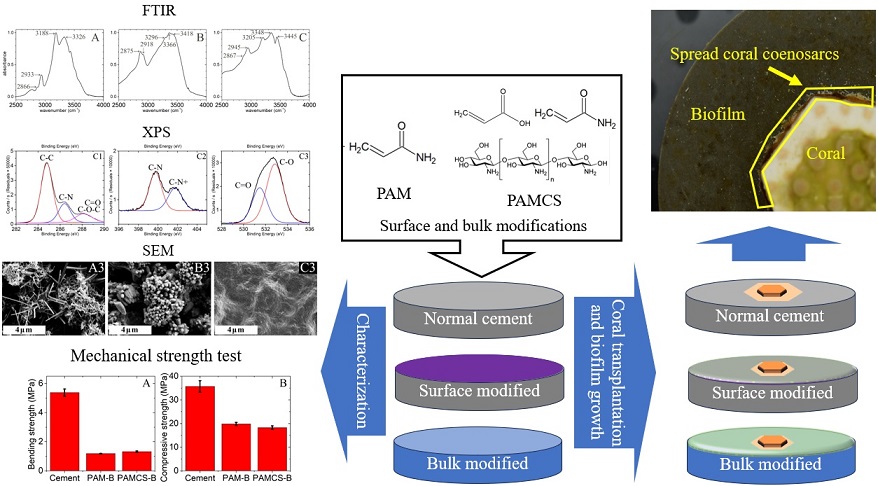WASHINGTON, Sept. 24, 2024 – Coastlines are vital to our world’s ecology and economy. Coastal ecosystems help maintain biodiversity, provide natural barriers against erosion, storms, and flooding, and act as large carbon sinks to reduce greenhouse gases. Sustainable fisheries and seaside tourist venues support local economies.
Natural coastlines, including coral reefs, marshes, and mangroves, are complete and stable, capable of self-regulation and restoration. That is, unless human interventions, such as urbanization, overdevelopment, pollution, and human-made erosion, make these areas vulnerable to devastation.
Artificial coastlines, including human-made dikes and other engineered constructions, can help prevent erosion and protect from storms and flooding. However, ecological functions remain unprotected from many of these structures.
In Biointerphases, an AVS journal published by AIP Publishing, researchers from Southeast University and the University of Chinese Academy of Science investigated the use of specialized types of cement for coastline ecological protection.
“New substrate materials need to be developed to reduce the biological toxicity effects on marine organisms,” said author Xiaolin Lu.
Current artificial reef blocks are built using cement with a highly alkaline pH of +12 which is harmful to biofilm on reef surfaces. Biofilm, made up of such microorganisms as bacteria, algae, and fungi, provides food for grazers and promotes larval settlement.
The team started with a limestone and clay cement that hardens underwater. Two types of treatments were added to the cement: polyacrylamide, a synthetic resin used in water treatment, and chitosan, a form of sugar made from the shells of shrimp and other crustaceans. The two treatments were mixed into the cement to form the hardened substrate, and they were sprayed onto previously hardened cement as a surface treatment.
The bulk-treated and surface-treated samples were tested for mechanical strength and biofilm and coral growth. The samples, along with a control of plain cement, were placed in a sea tank and treated with biofilm cultures and transplanted coral.
After two days, biofilm was found active and growing well on the surface-treated samples. After 30 days, biofilm growth was found to be greatest on the surface-treated samples, a little less on the bulk-treated samples, and significantly less on the cement control. The reduced biofilm growth on the control was attributed to the high alkalinity of the cement without anything to block its effects. Transplanted coral samples also survived and grew better on the surface-treated samples.
While the bulk-treated samples supported reduced survival and growth of both biofilm and coral, mechanical properties appeared to be significantly reduced compared to the control and the surface-treated samples.
“These new treatments showed the necessary biocompatibility in a simulated marine eco-environment, which can be used to promote biofilm growth without interfering in extended habitation of model coral samples,” said Lu.
Future research from the team will focus on long-term surface wear testing and biocompatibility in real-life applications.
###
The article “A phenomenological investigation of organic modified cements as biocompatible substrates interfacing model marine organisms” is authored by Jinglun Zhao, Tao Yuan, Hui Huang, and Xiaolin Lu. The article will appear in Biointerphases on Sept. 24, 2024 (DOI: 10.1116/6.0003811). After that date, it can be accessed at https://doi.org/10.1116/6.0003811.
ABOUT THE JOURNAL
Biointerphases, an AVS journal published by AIP Publishing, emphasizes quantitative characterization of biomaterials and biological interfaces. As an interdisciplinary journal, a strong foundation of chemistry, physics, biology, engineering, theory, and/or modelling is incorporated into original articles and reviews. See: https://pubs.aip.org/avs/bip.
ABOUT AVS
AVS is an interdisciplinary, professional society with some 4,500 members worldwide. Founded in 1953, AVS hosts local and international meetings, publishes four journals, serves members through awards, training and career services programs and supports networking among academic, industrial, government, and consulting professionals. Its members come from across the fields of chemistry, physics, biology, mathematics, engineering and business and share a common interest in basic science, technology development and commercialization related to materials, interfaces, and processing. See: https://www.avs.org.
###
